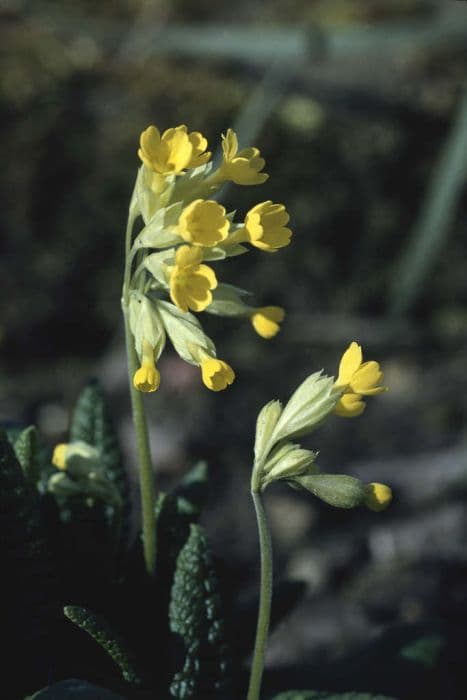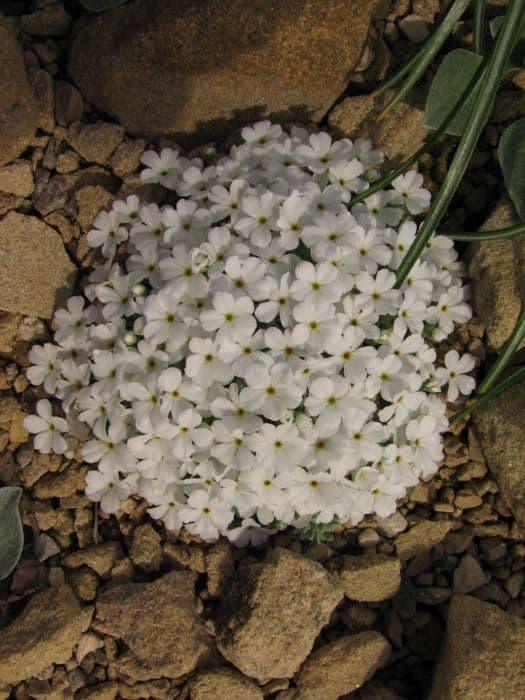Cowslip Primula veris (Pr)

ABOUT
The common name for Primula veris is cowslip. This plant is recognized for its rosette of tongue-shaped leaves that have a wrinkled texture, with the edges sometimes exhibiting a slight tooth-like appearance. The foliage is generally a fresh green color, contributing to a lush appearance near ground level. Above the rosette of leaves, bright yellow flowers bloom, each with five petals. These petals are rounded with a slight notch at the tip, giving them a unique look. The blooms are arranged in clusters at the top of a singular stalk that rises from the center of the leafy base, bearing an umbrella-like formation known as an umbel. Within each flower cluster, the individual flowers are cup-shaped and face outward, radiating in a circular fashion around the stalk. The yellow of the flowers is vibrant and often has a deep, golden hue, which can add a splash of color to areas where the cowslip grows. These characteristics, minus their specific dimensions, combine to form the distinctive and charming appearance of the cowslip that's beloved in gardens and wildflower meadows alike.
About this plant
 Names
NamesFamily
Primulaceae.
Synonyms
Cowslip, Cuy Lippe, Herb Peter, Paigle, Peggle, Key Flower, Key of Heaven, Fairy Cup, Petty Mulleins, Crewel, Buckles, Palsywort, Plumrocks, Mayflower.
Common names
Primula officinalis, Primula veris var. officinalis.
 Toxicity
ToxicityTo humans
Cowslip (Primula veris) is not considered highly toxic to humans. However, like many plants, it could potentially cause mild stomach upset if ingested in large quantities. It’s important to note that sensitivity to plant toxicity can vary among individuals. In rare cases, handling the plant may cause contact dermatitis in sensitive individuals. If any parts of the plant are consumed, especially in significant amounts, it may be wise to consult a medical professional, especially if symptoms such as nausea, vomiting, or diarrhea occur.
To pets
Cowslip (Primula veris) is generally not considered toxic to pets like cats and dogs. While not highly poisonous, ingestion of significant quantities of the plant could potentially lead to mild gastrointestinal upset, manifesting as symptoms such as vomiting or diarrhea. If a pet consumes a large amount of cowslip, or if any adverse reactions are observed, it is advisable to contact a veterinarian. Always err on the side of caution and prevent pets from eating ornamental plants.
 Characteristics
CharacteristicsLife cycle
Perennials
Foliage type
Deciduous
Color of leaves
Green
Flower color
Yellow
Height
0.5 feet (15 cm)
Spread
0.5 feet (15 cm)
Plant type
Herb
Hardiness zones
5
Native area
Europe
Benefits
 General Benefits
General Benefits- Attracts Pollinators: Pr is known to attract bees and butterflies, which are beneficial for pollination in gardens.
- Aesthetic Appeal: With its bright yellow flowers, Pr adds color and beauty to garden landscapes and can be used in ornamental planting schemes.
- Early Bloomer: As one of the first flowers to bloom in spring, it can provide early season nectar for insects emerging from hibernation.
- Drought Resistance: Pr can withstand periods of dryness once established, making it suitable for xeriscaping.
- Easy to Grow: It is relatively low maintenance and can thrive in a variety of soils, requiring minimal care once established.
- Culinary Use: The flowers of Pr, also known as cowslip, are edible and can be used to garnish or flavor food and drinks.
- Erosion Control: Pr's root system helps to stabilize soil and prevent erosion, especially on slopes or banks.
- Cultural Significance: Pr has a place in folklore and tradition, often associated with tranquility and peace.
- Wildlife Support: Provides habitat and food for various fauna, contributing to biodiversity.
 Medical Properties
Medical Properties- Expectorant: Primula veris, commonly known as Cowslip, has been traditionally used for its expectorant properties to help in the treatment of coughs and bronchitis.
- Sedative: It is believed to have mild sedative effects, which may promote relaxation and help in treating insomnia and anxiety.
- Diuretic: Cowslip may act as a diuretic, aiding in the excretion of urine and potentially assisting in the treatment of urinary tract infections.
- Anti-inflammatory: The plant has been used to reduce inflammation, particularly in the context of rheumatic pains and arthritis.
- Analgesic: There is a history of using Cowslip for its analgesic properties to alleviate pain, such as headaches.
 Air-purifying Qualities
Air-purifying QualitiesThis plant is not specifically known for air purifying qualities.
 Other Uses
Other Uses- Primula veris, commonly known as cowslip, can be used in the kitchen as a flavoring agent in jams and desserts, due to its sweet, slightly spicy flavor.
- The bright yellow flowers of cowslip are sometimes candied and used as an attractive and edible decoration for cakes and pastries.
- Cowslip petals are also used to infuse vinegar, imparting a subtle floral note to salad dressings and marinades.
- In some regions, cowslip flowers are incorporated into traditional wreaths and garlands for festive occasions, celebrating springtime and natural beauty.
- The plant is sometimes used in natural dyeing processes, where cowslip flowers yield a range of colors from yellow to greenish hues on wool and other natural fibers.
- As a natural beverage, cowslip flowers can be used to make a country wine with a unique flavor reminiscent of the plant's aromatic profile.
- Cowslip flowers can be utilized in potpourri mixes for their color and gentle scent that can freshen up a room without synthetic fragrances.
- Some cultures use cowslip blossoms in the creation of homemade syrups, which are then used to flavor drinks or drizzle over pancakes and waffles.
- In ornamental gardening, cowslip is planted not only for its beauty but also for its ability to attract pollinators like bees and butterflies, aiding in garden biodiversity.
- Traditional crafts may use dried cowslip blossoms to adorn hand-made paper, adding a touch of nature to personal correspondence and artwork.
Interesting Facts
 Feng Shui
Feng ShuiThe Cowslip is not used in Feng Shui practice.
 Zodiac Sign Compitability
Zodiac Sign CompitabilityThe Cowslip is not used in astrology practice.
 Plant Symbolism
Plant Symbolism- Youthfulness: Cowslip (Pr) often represents the essence of youth, possibly due to its fresh, vibrant blooms that appear in the spring.
- Healing: Historically, cowslip has been associated with healing because it was used in traditional medicine to treat various ailments.
- Fertility: The plant is also a symbol of fertility, which could be related to its lush growth and abundant flowering in nature.
- Prosperity: In some cultures, cowslip flowers are seen as a good omen for wealth and prosperity, potentially due to their golden color reminiscent of coins.
- Beautification: Cowslip has been used in folklore for cosmetic purposes, symbolizing the pursuit of beauty and grace.
 Water
WaterCowslip, or Primula veris, prefers consistent moisture and should be watered thoroughly once the top inch of soil feels dry to the touch, roughly every week. During active growth in spring and summer, it may require more frequent watering, potentially every few days, especially in warmer, drier climates. When watering, provide enough water to soak the soil around the roots without saturating the soil; approximately one or two gallons per week, depending on the size of the plant and environmental conditions. Over-watering or allowing the plant to sit in water can lead to root rot, so ensure proper drainage.
 Light
LightCowslip, also known as Primula veris, thrives in partial shade to full sun. The ideal location would be a spot that receives morning sun and afternoon shade, or dappled sunlight throughout the day. Avoid placing it in locations with intense, midday sun which can scorch the delicate leaves and flowers.
 Temperature
TemperatureCowslip, or Primula veris, fares best in cooler climates with temperatures ranging between 50 and 70 degrees Fahrenheit. It can tolerate a minimum temperature close to freezing at 32 degrees Fahrenheit and a maximum temperature of about 80 degrees Fahrenheit. The optimal growing conditions include cool nights and mild daytime temperatures.
 Pruning
PruningCowslip, also called Primula veris, should be pruned to remove spent flowers, a process known as deadheading, which encourages more blooms and prevents self-seeding if not desired. The best time for pruning is after blooming has finished in late spring or early summer. Generally, cut back the flower stalks to the base, and remove any dead or yellowing leaves to maintain plant health and appearance.
 Cleaning
CleaningAs needed
 Soil
SoilCowslip, or Primula veris, thrives in well-draining, moist soil with a pH of 6.0 to 7.0. A mix of loam, peat, and coarse sand is ideal for promoting healthy growth.
 Repotting
RepottingCowslip (Primula veris) should be repotted every one to two years or when it outgrows its current pot, ensuring not to disturb its delicate root system excessively.
 Humidity & Misting
Humidity & MistingCowslip prefers moderate humidity and can tolerate the typical humidity levels of temperate climates without needing special attention to humidity levels.
 Suitable locations
Suitable locationsIndoor
Place Cowslip in bright, indirect light with moist soil.
Outdoor
Plant Cowslip in partial shade and fertile, moist soil.
Hardiness zone
4-8 USDA
 Life cycle
Life cyclePrimula veris, commonly known as Cowslip, begins its life cycle as a seed, which germinates typically in spring when the soil temperature and moisture levels are adequate. Upon germination, the seedling emerges with a basic root system and a rosette of leaves. As the plant matures, it develops a deeper root system and a stronger rosette. The following spring, after a period of winter dormancy, Cowslip produces a flowering stalk with clusters of fragrant, bell-shaped, yellow flowers, which are pollinated by insects, leading to seed formation. After pollination and throughout the summer, seeds develop within the capsules, which, when mature, split open to disperse the seeds. Finishing its annual cycle, the foliage dies back in late autumn, and the plant enters dormancy again, ready to restart the cycle in the next growing season.
 Propogation
PropogationPropogation time
Spring to early summer
Primula veris, commonly known as cowslip, is typically propagated by seed. The most popular method is sowing seeds directly in the garden or into trays containing seed compost. It is best to sow seeds in late summer to early fall, as this allows the seedlings to undergo a period of cold stratification naturally, which is essential for germination. To propagate by seed, you should sprinkle the fine seeds onto well-drained, moist compost and lightly press them into the surface, avoiding covering them with soil as they require light to germinate. The tray should then be covered with glass or plastic and kept at around 65 degrees Fahrenheit (about 18 degrees Celsius). The seeds will usually germinate in two to three weeks, after which you can remove the cover and eventually transplant the seedlings to their final position when they are large enough to handle.









